WILL THE SALT LAKE CITY HOMELESSNESS PLAN BE A TORCHLIGHT FOR OTHER AMERICAN CITIES?
I’m about to break down a long, detailed news piece into clear, simple language so everyone can follow along.
This is about Utah’s plan to build a large homeless services “campus.”
I’ll explain what it is, where it goes, who supports it, who’s worried, how much it may cost, and what happens next.
Even though this story is set in Utah, the ideas connect to homelessness across the United States.
Let’s keep it short, straight, and easy to understand.
Utah wants to build a big, 1,300-bed campus in Salt Lake City that puts most help for unhoused people in one place—shelter, treatment, job help, legal help, and housing connections. State leaders say it’s a long-term fix. Some local leaders support it; others worry about impacts on nearby neighborhoods. The first part is planned to open in 2027, but money and community trust are the big hurdles.
What Is Being Built?
A 1,300-bed “transformative campus.”
Not just beds. It’s a one-stop hub: recovery and mental-health care, job support, help with the justice system, and direct links to housing.
It’s meant to add emergency shelter and help people move from crisis to stability.
Where Will It Be?
Address: 2520 N. 2200 West, Salt Lake City (Northpointe area).
West of I-215, near North Salt Lake.
The land is 15.85 acres now, with hopes to expand toward 30–40 acres by adding nearby open parcels over time.
Why This Approach?
State leaders say Utah’s population is growing and homelessness is rising.
They want a 50- to 100-year solution in one place instead of moving shelters every few years.
The model copies a well-known site in San Antonio called “Haven for Hope.”
How Will People Get There?
The area is not walkable from downtown.
Plan: expand shuttle service that already moves people to shelters.
They’re also talking with the transit agency about possible bus service.
The state says they’ll set up strong safety and security to limit neighborhood impacts.
Timeline
The state has signed a contract to acquire the land from Salt Lake City (purchase or land trade—final price pending).
A hard deadline of October 1, 2025 won’t be met.
First phase now targeted for 2027 (initial operations).
Price Tag (Big Picture)
Land value estimates: $5.7–$8.8 million (final number to be set after another appraisal).
The state has about $24 million on hand to buy land and start building.
Infrastructure build (roads, utilities, buildings) is estimated at about $75 million (not counting land).
Yearly operating costs are expected to be over $30 million.
The state will need the Utah Legislature and other funders to put in serious money.
Expansion Possibilities
Next-door is an 11.4-acre parcel owned by a local church stake; the state has talked with them about a possible future sale.
If added, the campus could reach around 40 acres total.
How It Will Work (The “Hub and Spoke” Plan)
People Step In to the main campus for core services.
When they stabilize, they Step Up and Step Out to focused programs across the community (the “spokes”).
The goal is fewer barriers, faster help, and better results.
Community Reactions (Support and Concerns)
Supportive voices:
The Salt Lake City mayor calls this a critical step to add beds and services, reduce emergency calls, and help first responders.
Worried voices:
The North Salt Lake mayor says the site choice process was too secretive and worries about impacts on his city. He floated tough talk about limiting access across a bridge, showing the tension here.
Two west-side state lawmakers say the west side already carries a heavy burden (like the state prison relocation) and want real community input, plus plans for transportation and safety before moving forward.
State response:
The homeless coordinator says land deals are always quiet at first. You secure the site, then hold public meetings and work through city processes.
He also says the campus will aim to lower neighborhood impacts so drastic moves like blocking bridges won’t be needed.
Legal Backdrop
Lawmakers gave the state eminent domain powers earlier this year if a city blocked the land transfer.
For this site, the state says it didn’t need to use that power.
What’s Next
Public meetings are planned so locals can give input.
Feasibility study is done; environmental studies are ongoing.
The office will seek funding partners and build a full budget plan for construction and operations.
Target: initial operations in 2027 if everything lines up.
Why This Matters Beyond Utah
Many U.S. cities debate centralized campuses vs. scattered services.
Key questions are the same everywhere:
Will it be funded every year?
Will transportation be reliable?
Will neighbors feel safe and respected?
Will it actually move people into stable housing?
Utah’s project will become a test case others watch.
That’s the heart of the Utah plan: a big, one-stop campus with beds and services, aiming for long-term change. Supporters see a smart way to help more people, faster. Critics worry about fairness, location, and how it affects nearby communities. The clock now runs on money, transit, safety plans, and real community input.
As we talk about homelessness across America, these same issues come up in every city: capacity, access, cost, coordination, and dignity.
Keep those five points in mind as we move into the wider national conversation next.
Here’s the link to the full article: https://utahnewsdispatch.com/2025/09/03/utah-homeless-campus-site-unveiled-after-secretive-search/





